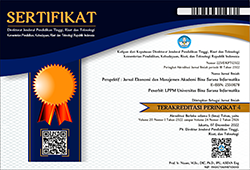Pemanfaatan Metode Scamper dalam Pengembangan Produk Kuliner untuk UMKM: Studi Kasus Produk Rendang Kacang
Abstract
The aim of this research is to find out how to develop culinary MSME products using the Scamper Method. This research uses a quantitative descriptive approach. Bunda's Rendang Shop located in Depok, West Java. Rendang Bunda Shop operates in the culinary sector. The product produced is beef rendang. The variables measured in this research are Strengths, Weaknesses, Opportunities and Threats of the peanut rendang product. The data analysis technique used is SWOT analysis. The results of the research show that the IFE analysis is 3.5, meaning that rendang kacang has quite good advantages, has unique and special strengths as an innovative product, and has more than enough prerequisites for further development. The results of the EFE analysis which is 3.6 means that if you look at the external business environment, Rendang Kacang has quite a large business opportunity. At the same time, there are also threats, even though the existing threats are relatively lower than the possible opportunities for development. With these results, the peanut rendang business still has the opportunity to grow. Innovation in the context of MSMEs: Innovation as the key to sustainability and growth of MSMEs. The role of innovation in increasing the competitiveness of MSMEs in the market. Impact of Innovation on MSMEs: Improved product and service quality, Product diversification to reach a wider market, Operational efficiency through process innovation. The Scamper Method is one way to develop culinary MSME products. This method can help culinary MSMEs to produce innovative and creative product development ideas. This method can be used by various types of companies, from large companies to small and medium companies.
Key Words : Scamper Method, Product Development, Rendang Kacang Products
Full Text:
PDFReferences
Adawiyah WR. (2013). Faktor Penghambat Pertumbuhan Usaha Mikro Kecil Menengah (UMKM): Studi di Kabupaten Banyumas. Sustainable Competitive Advantage (SCA). Jp FEB Unsoed.
Andriyanto, I. (2018). Penguatan Daya Saing Usaha Mikro Kecil Menengah Melalui E-Commerce. In BISNIS (Vol. 6, Issue 2).
Budiarto R, Putero SH, Suyatna H, Astuti P, Saptoadi H, Ridwan MM, & Susilo B. (2018). Pengembangan UMKM antara konseptual dan pengalaman praktis. UGM Press.
Kamis, A., Ghani Che Kob, C., Hustvedt, G., Mat Saad, N., Jamaluddin, R., & Bujeng, B. (2020). The effectiveness of SCAMPER techniques on creative thinking skills among fashion design vocational college. In EurAsian Journal of BioSciences Eurasia J Biosci (Vol. 14).
Kementerian Koordinator Bidang Perekonomian Indonesia. (2022). Perkembangan UMKM sebagai Critical Engine Perekonomian Nasional Terus Mendapatkan Dukungan Pemerintah. https://www.ekon.go.id/publikasi/detail/4593/perkembangan-umkm-sebagai-critical-engine-perekonomian-nasional-terus-mendapatkan-dukungan-pemerintah
Nabila Ghaida Zia. (2022). Strategi Pengembangan Produk Inovatif dengan Metode Scamper. Https://Www.Ekipa.Co.Id/Strategi-Pengembangan-Produk-Inovatif-Dengan-Metode-Scamper/.
Priyanto H. (2017). The Effect of Innovation on Small and Medium-Sized Enterprises’ (SMEs) Business Performance: A Conceptual Framework. KnE Social Sciences, 1(10), 1229–1241.
Rahma Rina Wijayanti, dan. (n.d.). Strategi Pemberdayaan UMKM Menghadapi Pasar Bebas Asean.
Santoso, A. (2018). Inovasi Produk dan Proses dalam Peningkatan Daya Saing UMKM. Jurnal Manajemen Dan Kewirausahaan, 20(1), 1–10.
Suhaeni, T., Administrasi Niaga, J., & Negeri Bandung, P. (2018). Pengaruh Strategi Inovasi Terhadap Keunggulan Bersaing di Industri Kreatif (Studi Kasus UMKM Bidang Kerajinan Tangan di Kota Bandung). Jurnal Riset Bisnis Dan Investasi, 4(1), 57.
Yuliani, N., & Novita, D. (2023). Strategi Bisnis Pada Industri Hilir Plastik Melalui Pendekatan Internal External Matrix-IE Matrix (Studi kasus : PT Cemerlang Utama Plastik). https://journals.upi-yai.ac.id/index.php/IKRAITH-EKONOMIKA
DOI: https://doi.org/10.31294/jp.v22i1.21360
Copyright (c) 2024 Nafisah Yuliani

This work is licensed under a Creative Commons Attribution-ShareAlike 4.0 International License.
dipublikasikan oleh LPPM Universitas Bina Sarana Informatika Jakarta
Jl. Kramat Raya No.98, Kwitang, Kec. Senen, Kota Jakarta Pusat, DKI Jakarta 10450

This work is licensed under a Creative Commons Attribution-ShareAlike 4.0 International License









